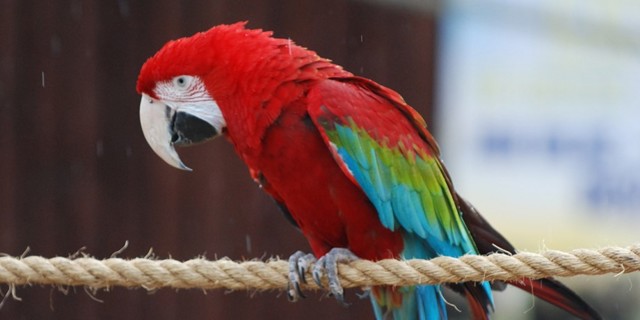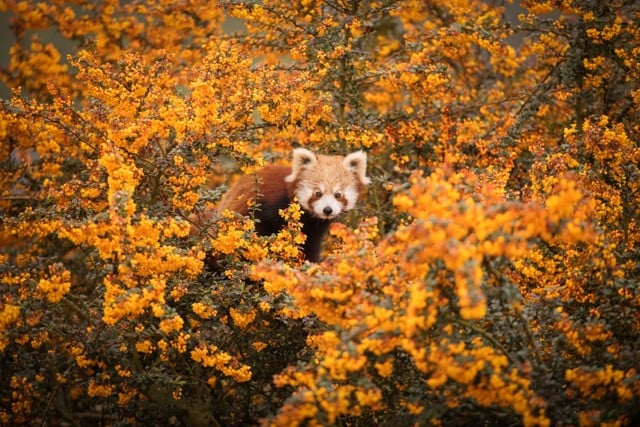
Overview
The green-winged macaw is also known as the red-and-green macaw, and is among the largest of the macaw species.
Woburn Safari Park is home to three species of macaw, including the blue-and-gold macaw, and the military macaw. Experience Woburn Safari Park’s free-flying bird demonstration, and see these magnificent parrots soaring and swooping in the Foot Safari. Learn about these intelligent birds, how they adapt and survive in the wild.

All about us
| Distribution: | Central and Southern America including Brazil, Paraguay, Peru and Bolivia |
|---|---|
| Habitat: | Rainforests, lowlands and lower foothills |
| Height: | 66-99cm (from beak to tail). Wingspan 104-125cm |
| Weight: | 1200-1700g |
| Lifespan: | Up to 60 years |
| Threats: | Habitat loss, hunting, pet trade and introduced species |
About us
Scientific name: Ara chloroptera
Green-winged macaws are very expressive, communicating through sight and sound. They show emotion by vocalizing, flashing their eyes (voluntary narrowing their pupils), blushing and cocking their head. Other forms of communication include fluffing of the feathers, bowing, shaking of tail feathers, head bobbing and raising of the wings. They also use flock calls which are loud vocalizations to communicate.

The chest is bright red. The shoulders or upper wings are red, as is the upper back and head; the middle wing feathers are green, turning blue toward the tips. On the tail, iridescent teal feathers are surrounded by red. There are characteristic bright red lines around the eyes formed by rows of tiny isolated feathers on the otherwise bare white skin cheeks. Upper mandible (beak) is mostly ivory-white with cutting edge black, the lower mandible is also black. Their iris’ (eyes) are pale yellow and legs are grey.
Adult female and male green-winged macaws are similar in size, weight and colour. All species of macaws are monomorphic, which means that there are no obvious differences between the sexes, not even by their plumage or physical indicators. Young macaws will have dark brown pupils while an adult bird will have yellow rings around the pupils and the tails are shorter. To determine the gender of adult birds, a blood test or DNA test could be taken.
Parrots mainly eat plant parts. Seeds, fruits, blossoms, buds, leaves, berries, nuts and sometimes bark are principal known food items. The Macaws are structurally adapted with their massively powerful bills (beaks) exploiting various palm nuts. They have the ability to manipulate food items, moving them with their feet, testing them with their dry tongues, and tossing food around in their beaks.
A wide range of parrots visit earth banks to take mineral rich soil; here they congregate in very large numbers. Visiting clay banks to take mineral deposits has a very important function as this helps neutralise the toxic effects of poisons ingested from fruits or plants.
Green-winged macaws reach maturity when they are about 2 to 3 years old. They display courtship rituals to indicate they have found a suitable mate; they are generally monogamous (paired for life). However, they may replace a mate that they have lost. Most breeding activities occur from January to July and they usually breed every 1 to 2 years. In their natural habitat, they nest in the hollow trunks of dead palm trees or cavities (natural or excavated by other birds) in tall trees high up to avoid predation. They will lay 1-3 eggs and are incubated for 25-28 days.
The hatchlings are blind, featherless and completely dependent on parental care. For the first week, the female alone feeds the young through regurgitation and after that time, the male will usually assist. About 10 days later, the young develop feathers .Both parents are very protective of their young and aggressively defend them against intruders. The young fledge the nest when they are about 90 days old and independent at about 20 weeks.
Parrots at risk in the wild face a wide range of pressures. The main sources of threat arise from habitat loss, hunting and introduced species. Bringing a new species into the habitat can cause problems for native wildlife because of predation and competition for food. Collection of birds for the live pet trade has been a major threat for many species of parrots. These birds high level of intelligence, potential for tameness, bright plumage and the ability to mimic human voices, have led to the parrot’s popularity as cage birds.
Zoos and other institutions seek to maintain captive populations in order to safeguard against possible extinction in the wild. This breeding is sometimes well coordinated and orchestrates through the use of studbook keepers. Other breeding is undertaken commercially to meet demands of the pet trade, sometimes to the extent that species have self-sustaining captive populations that no longer need to be increased with wild caught birds (for example budgerigar, cockatiel and several species of lovebird).
There are unfortunately draw backs to captive breeding. Some of the species are at such low levels that trapping for captive breeding would only worsen their wild status. Captive breeding may do nothing to reduce the pressures which have rendered a parrot species scarce. Habitat loss, illegal capture or the effects of introduced predators may continue meaning if successful breeding is achieved in captivity, there may not be a wild habitat to release the parrots into.
The green-winged macaw has a very powerful beak which can generate a pressure of 2000 psi (pounds per square inch) and has the ability to crack open incredibly hard-shelled nuts (such as Brazil nuts) with ease.
Macaws have "zygodactyl" feet with two middle toes facing forward and the two outside toes facing backward.

